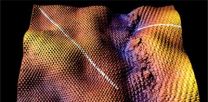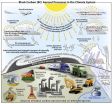(Press-News.org) Safety fears about carbon nanotubes, due to their structural similarity to asbestos, have been alleviated following research showing that reducing their length removes their toxic properties.
In a new study, published today in the journal Angewandte Chemie, evidence is provided that the asbestos-like reactivity and pathogenicity reported for long, pristine nanotubes can be completely alleviated if their surface is modified and their effective length is reduced as a result of chemical treatment.
First atomically described in the 1990s, carbon nanotubes are sheets of carbon atoms rolled up into hollow tubes just a few nanometres in diameter. Engineered carbon nanotubes can be chemically modified, with the addition of chemotherapeutic drugs, fluorescent tags or nucleic acids – opening up applications in cancer and gene therapy.
Furthermore, these chemically modified carbon nanotubes can pierce the cell membrane, acting as a kind of 'nano-needle', allowing the possibility of efficient transport of therapeutic and diagnostic agents directly into the cytoplasm of cells.
Among their downsides however, have been concerns about their safety profile. One of the most serious concerns, highlighted in 2008, involves the carcinogenic risk from the exposure and persistence of such fibres in the body. Some studies indicate that when long untreated carbon nanotubes are injected to the abdominal cavity of mice they can induce unwanted responses resembling those associated with exposure to certain asbestos fibres.
In this paper, the authors describe two different reactions which ask if any chemical modification can render the nanotubes non-toxic. They conclude that not all chemical treatments alleviate the toxicity risks associated with the material. Only those reactions that are able to render carbon nanotubes short and stably suspended in biological fluids without aggregation are able to result in safe, risk-free material.
Professor Kostas Kostarelos, Chair of Nanomedicine at the UCL School of Pharmacy who led the research with his long term collaborators Doctor Alberto Bianco of the CNRS in Strasbourg, France and Professor Maurizio Prato of the University of Trieste, Italy, said: "The apparent structural similarity between carbon nanotubes and asbestos fibres has generated serious concerns about their safety profile and has resulted in many unreasonable proposals of a halt in the use of these materials even in well-controlled and strictly regulated applications, such as biomedical ones. What we show for the first time is that in order to design risk-free carbon nanotubes both chemical treatment and shortening are needed."
He added: "Creative strategies to identify the characteristics that nanoparticles should possess in order to be rendered 'safe-for-use', and the ways to achieve that, are essential as nanotechnology and its tools are maturing into applications and becoming part of our everyday lives."
### Notes for Editors
1. For more information, please contact Professor Kostas Kostarelos on tel: +44 (0)207 753 5956, email: k.kostarelos@ucl.ac.uk
2. Alternatively, please contact Clare Ryan in the UCL Media Relations Office on tel: +44 (0)20 3108 3846, mobile: +44 07747 556 056, out of hours +44 (0)7917 271 364, e-mail: clare.ryan@ucl.ac.uk
3. 'Asbestos-like pathogenicity of long carbon nanotubes alleviated by chemical functionalization' is published in the journal Angewandte Chemie on 15 January. Journalists can obtain copies of the paper by contacting the UCL Media Relations Office.
4. The paper is published online here: http://onlinelibrary.wiley.com/doi/10.1002/anie.201207664/abstract
About UCL (University College London)
Founded in 1826, UCL was the first English university established after Oxford and Cambridge, the first to admit students regardless of race, class, religion or gender and the first to provide systematic teaching of law, architecture and medicine.
We are among the world's top universities, as reflected by our performance in a range of international rankings and tables. According to the Thomson Scientific Citation Index, UCL is the second most highly cited European university and the 15th most highly cited in the world.
UCL has nearly 25,000 students from 150 countries and more than 9,000 employees, of whom one third are from outside the UK. The university is based in Bloomsbury in the heart of London, but also has two international campuses – UCL Australia and UCL Qatar. Our annual income is more than £800 million.
www.ucl.ac.uk | Follow us on Twitter @uclnews | Watch our YouTube channel YouTube.com/UCLTV
Chemistry resolves toxic concerns about carbon nanotubes
2013-01-15
ELSE PRESS RELEASES FROM THIS DATE:
Born to lead? Leadership can be an inherited trait, study finds
2013-01-15
Genetic differences are significantly associated with the likelihood that people take on managerial responsibilities, according to new research from UCL (University College London).
The study, published online in Leadership Quarterly, is the first to identify a specific DNA sequence associated with the tendency for individuals to occupy a leadership position. Using a large twin sample, the international research team, which included academics from Harvard, NYU, and the University of California, estimate that a quarter of the observed variation in leadership behaviour ...
Neon lights up exploding stars
2013-01-15
An international team of nuclear astrophysicists has shed new light on the explosive stellar events known as novae.
These dramatic explosions are driven by nuclear processes and make previously unseen stars visible for a short time. The team of scientists measured the nuclear structure of the radioactive neon produced through this process in unprecedented detail.
Their findings, reported in the US journal Physical Review Letters, show there is much less uncertainty in how quickly one of the key nuclear reactions will occur as well as in the final abundance of radioactive ...
New research gives insight into graphene grain boundaries
2013-01-15
Using graphene – either as an alternative to, or most likely as a complementary material with – silicon, offers the promise of much faster future electronics, along with several other advantages over the commonly used semiconductor. However, creating the one-atom thick sheets of carbon known as graphene in a way that could be easily integrated into mass production methods has proven difficult.
When graphene is grown, lattices of the carbon grains are formed randomly, linked together at different angles of orientation in a hexagonal network. However, when those orientations ...
Facebook posts not easily forgotten
2013-01-15
Facebook posts resonate significantly more with human nature than books or even human faces, according to a new study by Laura Mickes and colleagues from the University of California San Diego in the US. The difference in memory between these microblogs and actual published words from a page is as striking as the difference in memory between amnesiacs and healthy controls. The work is published online in Springer's journal Memory & Cognition.
Online social networking is very popular, and allows people to post their thoughts as microblogs, an opportunity that people exploit ...
The muscle response of footballers depends on their position on the field
2013-01-15
Football players display different muscle response parameters depending on the position that they hold on the pitch, according to a study conducted by a team of Spanish researchers which has been published in the 'Journal of electromyography and kinesiology'.
Scientists from the University of Vigo have analysed different muscle response parameters in 78 Spanish first division footballers who have been playing for between four and fifteen years. They found variations depending on the field position of the players.
Published in the 'Journal of Electromyography and Kinesiology', ...
Black carbon larger cause of climate change than previously assessed
2013-01-15
Black carbon is the second largest man-made contributor to global warming and its influence on climate has been greatly underestimated, according to the first quantitative and comprehensive analysis of this issue.
The landmark study published in the Journal of Geophysical Research-Atmospheres today says the direct influence of black carbon, or soot, on warming the climate could be about twice previous estimates. Accounting for all of the ways it can affect climate, black carbon is believed to have a warming effect of about 1.1 Watts per square meter (W/m2), approximately ...
No panaceas for Mexico's violent drug war, but prohibition has failed
2013-01-15
While Mexico and the United States have ramped up their efforts to control and perhaps defeat Mexico's increasingly violent drug cartels, the outcome of these efforts remains in doubt and no panaceas are in sight, but prohibition has once again proved to be a failure, according to a paper from Rice University's Baker Institute for Public Policy.
The paper by Rice sociologist William Martin, "Cartels, Corruption and Carnage in the Calderón Era," traces the origins and growth of Mexican drug cartels and the corruption, failed government policies and gruesome violence ...
In search of the big questions: Conserving the European Alps
2013-01-15
The European Alps range span eight countries from France to Slovenia and harbour an extraordinary diversity of habitats, plants and animals, including many species found nowhere else. They are widely considered to be one of the most important regions for the preservation of biodiversity in Europe. But the Alps are not just a natural paradise: they are the home and workplace of up to 14 million people and the destination for more than 100 million tourists each year. The resulting changes to the landscape have led to an increasing fragmentation of the plant and animal ...
EGFR mutation not prognostic factor in non-small cell lung cancer
2013-01-15
DENVER – Recent studies have demonstrated that molecular-targeted agents, such as epidermal growth factor receptor (EGFR) tyrosine kinase inhibitors (TKI), may prolong survival of selected patients based on tumor biomarkers. The presence of mutation in the EGFR gene is known as a predictive marker for the response to treatment. However, whether or not these EGFR mutations are prognostic factors for non-small cell lung cancer (NSCLC) has not been known. A recent study published in the February 2013 issue of the International Association for the Study of Lung Cancer's (IASLC) ...
Patients with EGFR exon 20 insertions have poorer prognosis
2013-01-15
DENVER – Exon 20 insertions are the third most common family of epidermal growth factor receptor (EGFR) mutations found in non–small-cell lung cancer (NSCLC). Little is known about cancers harboring these mutations aside from their lack of response to EGFR tyrosine kinase inhibitors, impairing the development of effective targeted therapies. A recent study published in the February 2013 issue of the International Association for the Study of Lung Cancer's (IASLC) Journal of Thoracic Oncology, concludes that patients with EGFR exon 20 insertions have similar clinical characteristics ...


